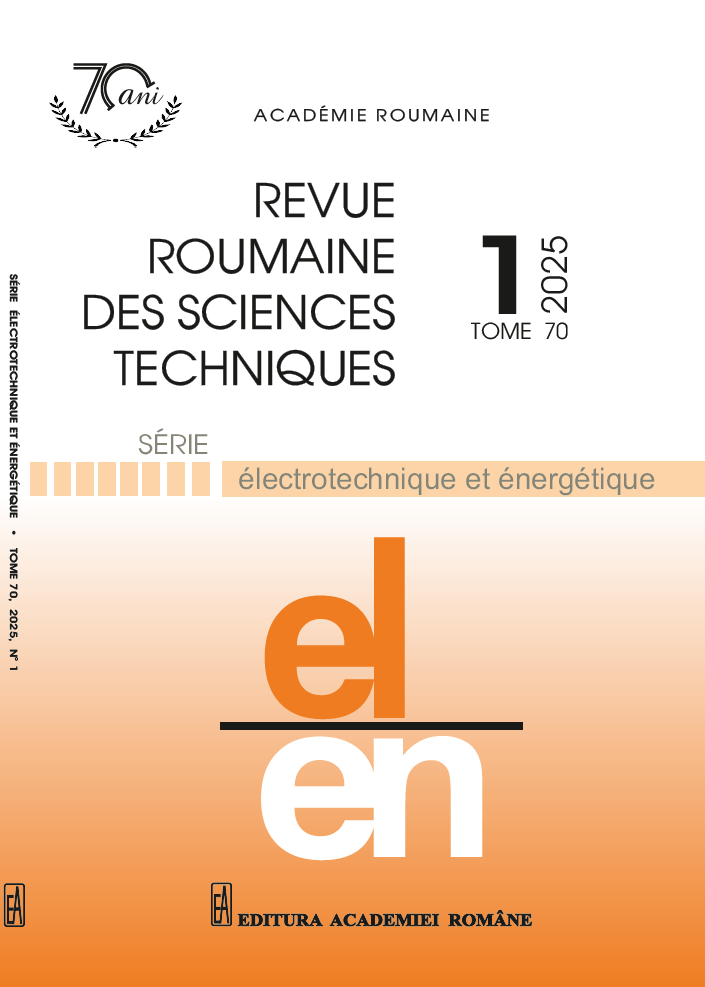BILAN DES FLUX DE PUISSANCE – SIMULATIONS ET EXPÉRIENCES DANS LES RÉSEAUX ÉLECTRIQUES
DOI :
https://doi.org/10.59277/RRST-EE.2025.1.9Mots-clés :
Réseau de distribution, Puissance active, Puissance réactive, Consommateurs déséquilibrés, Consommateurs non linéaires, Théorie de la puissance à composantes symétriques (SCPT), Puissances de symétrie, Puissances de non-symétrie, Puissances résiduelles (déformantes), Harmoniques, Simulation numériqueRésumé
Cet article fournit une analyse détaillée des effets du transfert d'énergie électrique dans les régimes déformés et asymétriques spécifiques aux systèmes triphasés à quatre fils, en analysant et en exposant l'influence négative des consommateurs non linéaires et déséquilibrés sur les autres consommateurs connectés au réseau et sur la ligne électrique. Un aspect clé de cette étude est d'étudier l'impact de ces régimes sur les puissances actives et réactives parasites, qui affectent les consommateurs linéaires et équilibrés en raison de charges déformées et déséquilibrées. L'évaluation quantitative des phénomènes impliqués est réalisée grâce à la théorie de la puissance à composante symétrique (SCPT), introduite par l'académicien Andrei Țugulea, permettant d'identifier la source de la non-symétrie et des puissances résiduelles. Cette approche est cohérente avec les données expérimentales acquises lors de nos recherches précédentes, prouvant la validité de la SCPT. La simulation du circuit a été réalisée avec le logiciel SPICE, confirmant la cohérence entre les données acquises expérimentalement et celles fournies par la simulation numérique.
Références
(1) D.R. Corrêa, A. Silva de Morais, F.L. Tofoli, Non-isolated quadratic SEPIC converter without electrolytic capacitors for LED driver applications, 15th Brazilian Power Electronics and 5th IEEE Southern Power Electronics Conference, pp. 1–7 (2019).
(2) Y. Wang, J.M. Alonso, X. Ruan, A review of LED drivers and related technologies, IEEE Trans. Ind. Electron., 64, 7, pp. 5754–5765 (2017).
(3) C.C. Raicu, G.C. Seritan, B. Enache, 48 V network adoption for automotive lighting systems, Rev. Roum. Sci. Techn. – Électrotechn. et Énerg., 66, 4, pp. 231–236 (2021).
(4) G. Vacheva, N. Hinov, B. Gilev, Computer investigation of SEPIC DC-DC converter for LED lighting applications, Second Balkan Junior Conference on Lighting, pp. 1–4 (2019).
(5) J. Singh, P. Mahajan, R. Garg, Design & implementation of solar fed intensity-controlled streetlight, 2nd IEEE International Conference on Power Electronics, Intelligent Control, and Energy Systems, pp. 671–676 (2018).
(6) S. Ahmad, N.M.L. Tan, M.Z. Baharuddin, G. Buticchi, A high-performance isolated SEPIC converter for non-electrolytic LED lighting, in IEEE Access, 9, pp. 149894–149905 (2021).
(7) V. Naithani, A.N. Tiwari, S. Dobhal, Simulation of SEPIC converter fed LED’s, International Journal of Engineering Science and Technology, 4, 3, pp. 1015–1020 (2012).
(8) S. Singh, B. Singh, Single-phase SEPIC based PFC converter for PMBLDC motor drive in air-conditioning system, Asian Power Electronics Journal, 4, 1, pp. 16–21 (2010).
(9) D.S.L. Simonetti, J. Sebastian, J. Uceda, The discontinuous conduction mode SEPIC and CUK power factor pre-regulators: analysis and design, in IEEE Trans. on Industrial Electronics, 44, 5, pp. 630–637 (1997).
(10) A. Sureshkumar, R. Gunabalan, Design and implementation of single switch control DC-DC converter with wide input variation in automotive LED lighting, Int. Trans. Elect. Energy Syst., 31, 4 (2021).
(11) M. Dalla Vecchia, G. Van den Broeck, S. Ravyts, J. Tant, J. Driesen, A family of DC–DC converters with high step-down voltage capability based on the valley-fill switched capacitor principle, in IEEE Transactions on Industrial Electronics, 68, 7, pp. 5810–5820 (2021).
(12) S. Hariprasath, R. Balamurugan, A valley-fill SEPIC-derived power factor correction topology for LED lighting applications using one cycle control technique, International Conference on Computer Communication and Informatics, IEEE (2013).
(13) H. Ma, C. Zheng, W. Yu, J.-S. Lai, Bridgeless electrolytic capacitor-less valley fill AC/DC converter for twin-bus type LED lighting applications, 1st International Future Energy Electronics Conference, pp. 304–310 (2013).
(14) D. Dah, C. Lu, Analysis of an AC-DC valley-fill power factor corrector, ECTI Transactions on Electrical Eng., Electronics, and Communications, 5, 2 (2007).
(15) N. Molavi, H. Farzanehfard, Load-independent hybrid resonant converter for automotive LED driver applications, in IEEE Trans. on Power Electronics, 377, pp. 8199–8206 (2022).
(16) Z. Zhang, J. Lin, Y. Zhou, X. Ren, Analysis and decoupling design of a 30 MHz resonant SEPIC converter, in IEEE Transactions on Power Electronics, 31, 6, pp. 4536–4548 (2016).
(17) A. Ţugulea, Power flows under non-sinusoidal and non-symmetric periodic and almost periodic steady states of electrical power system, Proc. of 6th Int. Conf. On Harmonics in Power Systems (ICHPS VI), Bologna, Italy, pp. 388–395 (1994).
(18) A. Ţugulea, Criteria for the definition of the electric power quality and its measurement systems, European Transactions on Electrical Power, 6, 5, pp. 357–363 (1996).
(19) R.M. Ciuceanu, I.V. Nemoianu, V. Mănescu (Păltânea), G. Păltânea, On professor Ţugulea’s visionary power theory: a review, recent advances and perspectives, Roum. Sci. Techn. – Électrotechn. et Énerg., 63, 2, pp. 123–127 (2018).
(20) I.V. Nemoianu, R.M. Ciuceanu, Non-symmetry and residual active and reactive powers flow in non-linear three-phase unbalanced circuits, Roum. Sci. Techn. – Électrotechn. et Énerg., 60, 2, pp. 227–237 (2015).
(21) I.V. Nemoianu, R.M. Ciuceanu, Characterization of non-linear three-phase unbalanced circuits powers flow supplied with symmetrical voltages, Roum. Sci. Techn. – Électrotechn. et Énerg., 60, 3, pp. 355–365 (2015).
(22) B.D.H. Tellegen, A general network theorem, with applications, Philips Res. Rep., 7, pp. 259–269 (1952).
Téléchargements
Publiée
Numéro
Rubrique
Licence
(c) Copyright REVUE ROUMAINE DES SCIENCES TECHNIQUES — SÉRIE ÉLECTROTECHNIQUE ET ÉNERGÉTIQUE 2025

Ce travail est disponible sous licence Creative Commons Attribution - Pas d'Utilisation Commerciale - Pas de Modification 4.0 International.


